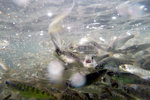

Last summer, the Washington Department of Fish and Wildlife lost more than 500,000 summer steelhead and cutthroat trout smolts that were destined to be released in the Cowlitz River. Officials thought the fish were in the rearing ponds at the Cowlitz Trout Hatchery, but when it came time to release the fish, the numbers simply were not there.
After keeping the losses under wraps for months, the WDFW eventually admitted to the discrepancy and placed the blame jointly on a menacing contingent of hungry birds, who supposedly raided the hatchery pens, as well as what they insisted was a faulty fish counting machine.
But when it was time to release the summer trout smolts again this year, the WDFW wound up with a brand new problem. This time around, the fish counting machine tabulated a release that was actually larger than the original number of fish placed in the rearing ponds to begin with.
With the juvenile fish flushed downstream on their way to the ocean, there was no way to recount the fish, so the WDFW decided to disregard the elevated release numbers in favor of estimating release numbers based on known average mortality rates for hatchery fish during the rearing process.
“Toward the end of the release period, WDFW staff discovered that the fish counter had recorded more fish than were originally put in the ponds. To account for this inaccuracy, the organizations estimated this year’s releases by applying natural mortality and predation rates,” explained Chris Gleason, community and media services manager for Tacoma Public Utilities, in an email to The Chronicle.
Gleason noted that the natural mortality rate for hatchery fish within the facility is 0.52 percent while the predation rate is 5.4 percent.
“If you remember we believe predation was a significant factor in the release numbers (last year),” Gleason wrote in an email. “We did not estimate predation rates last year. We relied entirely on the counter to estimate the number of fish released last year.”
Using an entirely new process, the WDFW, which is contracted to run the fish facility for Tacoma Power, estimated that they released a total of 1,441,000 cutthroat trout, as well as winter and summer steelhead. Broken down by species, the WDFW estimated that they released between 85,000 and 110,000 cutthroat trout, between 485,000 and 635,000 summer steelhead and between 631,000 and 696,000 late-winter steelhead.
While those estimates place the WDFW within their targeted release goal, the numbers are far from foolproof and they have done little to inspire confidence in anglers, environmentalists or politicians who are still dizzy from the half million fish that turned up missing last summer.
“I’ve got constituents who are furious about all of this,” said Jim Walsh, a Republican state representative from Washington’s 19th District. “This is like a pendulum swing. It’s wrong one way too much. It’s wrong the other way. I mean you can blame the equipment, but when I was a kid we used to make a joke that if you make a mistake, blame the equipment.”
Gleason insists that measures were taken in order to ensure the accuracy of the fish counters this year after the missing fish fiasco of 2016. Namely, the Cowlitz Trout Hatchery fish counter was sent back to the manufacturer for recalibration, but for whatever reason, that due diligence didn’t pay dividends for the department.
“Historically, the counters have been sent to the manufacturer every two to three years for calibration, system checks and repairs. It was calibrated by the manufacturer prior to installation this year,” noted Gleason in an email. “Accuracy is tested in place during the fish release period and has been tested once a year. A system check is performed daily as per (the) manufacturer provided test button. The test confirms the counter is on and counting.”
While he appreciates that those preemptive efforts took place, Walsh said it’s beyond time to turn the tide on what he sees as failing state fish programs before it’s too late.
“The overall trend is bad and now we have a complete lack of clarity. Now we have sort of unreliable, uncertain, near-term estimating. It doesn’t change the overall trend and it doesn’t give most recreational fishermen, and certainly not commercial fishermen, hope that the trend has really turned,” said Walsh. “This is all a part of a larger problem of there not being enough fish on any of the rivers. It’s like this is almost a distraction to the larger issue, which is that there are just not enough fish. We can talk about this count or that count, but where does the rubber meet the road? Where do the fish meet the water? And where the fish meet the water, the fact is that there just isn’t enough fish.”
Walsh added that he hopes “the goofiness of these numbers helps people to see that there is a problem and then wakes people up.”
“The department obviously has some sort of issues. Now they can say that its hardware, but I suspect that it runs deeper than that. We’ve got a department that has issues beyond this river and beyond this hatchery,” said Walsh. “I don’t mean to laugh too hard at their problems. I think they have some good people who are trying hard, but I think they’ve got management problems there. There’s just no really polite way to say that, but I think there is change needed there.”
For its part, Tacoma Power insists it has already begun to make improvements to the Cowlitz Trout Hatchery in order to head off similar problems in the future.
“We put in multiple protective measures this year, including extended (predator) hazing to all daylight hours throughout the season, installing duck-deterring fencing, adding fishing line across the ponds to help prevent birds from landing, (and) installing nets that blocked the perimeter of the ponds,” noted Gleason. “For 2018, we are designing a study to test the counter accuracy and will be able apply a correction factor to obtain a more accurate estimate. We will also complete upgrades that will improve the rearing ponds to help lower the predation and mortality rates.”
Looking ahead to 2019, Gleason said there will be additional upgrades to the hatchery and stated the department’s intention to either fix the old counter or install a new one.
Walsh said improvements and fixes with tangible results need to be put in place sooner rather than later. He insinuated that the Legislature will not continue to throw good money after bad for a department with a growing history of costly mistakes that ultimately send costly ripples through the various economies of the state.
“Remember, when this is run right by the Fish and Wildlife, there is so much tax revenue generated by commercial and recreational fishing that back in its heyday this thing was a net money maker. But those days are gone,” said Walsh. “There are analogies between this and the timber industry. These were industries that used to put money into the state accounts. The idea that they are now beggars is just crazy.”